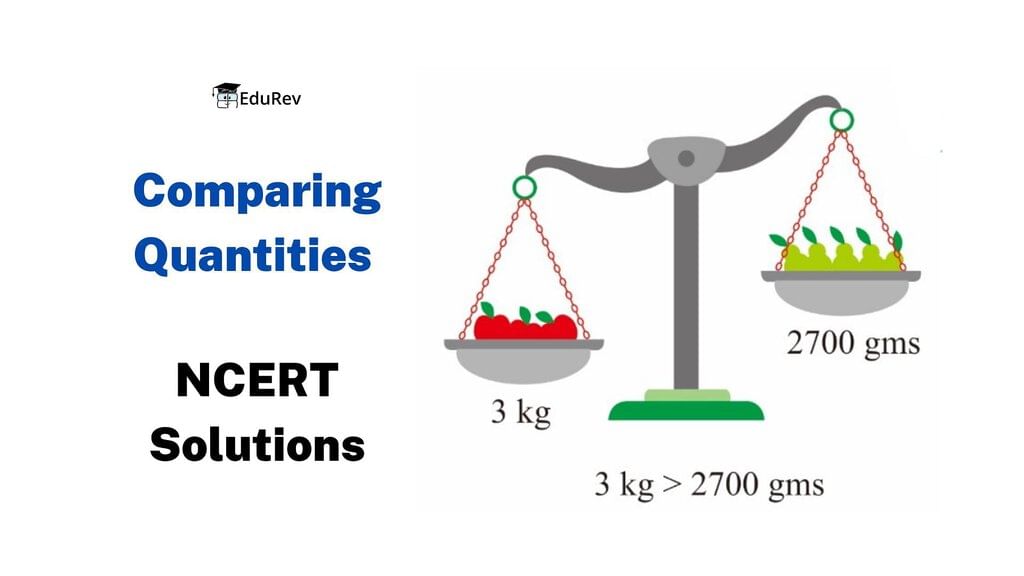NCERT Solutions for Class 8 Maths - Comparing Quantities - 2 (Exercise 7.2)

Exercise 7.2
Q1: During a sale, a shop offered a discount of 10% on the marked prices of all the items. What would a customer have to pay for a pair of jeans marked at ₹ 1450 and two shirts marked at ₹ 850 each?
Ans: Total marked price = ₹ (1,450 + 2 × 850)
= ₹ (1,450 +1,700)
= ₹ 3,150
Given that, the discount percentage = 10%
Discount = ₹ (10/100 x 3150) = ₹ 315
Also, Discount = Marked price − Sale price
₹ 315 = ₹ 3150 − Sale price
∴ Sale price = ₹ (3150 − 315)
= ₹ 2835
Therefore, the customer will have to pay ₹ 2,835.
Q2: The price of a TV is ₹ 13,000. The sales tax charged on it is at the rate of 12%. Find the amount that Vinod will have to pay if he buys it.
Ans: On ₹ 100, the tax to be paid = ₹ 12
Here, on ₹ 13000, the tax to be paid will be = 12/100 × 13000
= ₹ 1560
Required amount = Cost + Sales Tax
= ₹ 13000 + ₹ 1560
= ₹ 14560
Therefore, Vinod will have to pay ₹ 14,560 for the TV.
Q3: Arun bought a pair of skates at a sale where the discount given was 20%. If the amount he pays is ₹ 1,600, find the marked price.
Ans: Let the marked price be x
Discount percent = Discount/Marked Price x 100
20 = Discount/x × 100
Discount = 20/100 × x
= x/5
Also,
Discount = Marked price – Sale price
x/5 = x – ₹ 1600
x – x/5 = 1600
4x/5 = 1600
x = 1600 x 5/4
= 2000
Therefore, the marked price was ₹ 2000.
Q4: I purchased a hair-dryer for ₹ 5,400 including 8% VAT. Find the price before VAT was added.
Ans: The price includes VAT
So, 8% VAT means that if the price without VAT is ₹ 100,
Then, the price including VAT will be ₹ 108
When price including VAT is ₹ 108, original price = ₹ 100
When price including VAT is ₹ 5400, original price = ₹ (100/108 × 5400)
= ₹ 5000
Therefore, the price of the hair dryer before the addition of VAT was ₹ 5,000.
Q5: An article was purchased for ₹ 1239 including GST of 18%. Find the price of the article before GST was added?
Ans: Let the Price of the article before including GST be x
Price of article including GST = ₹ 1239
GST(Goods and Service Tax) = 18 % of x = (18 × x) = 0.18 × x
∴ Price of article including GST = Price before GST + GST
⇒ x + (0.18x) = 1239
⇒ 1.18x = 1239
∴ x = 1239/1.18 = ₹ 1050
So, the price of article before GST was added = ₹ 1050
|
276 docs|155 tests
|
FAQs on NCERT Solutions for Class 8 Maths - Comparing Quantities - 2 (Exercise 7.2)
| 1. What is compound interest? |  |
| 2. How is compound interest different from simple interest? |  |
| 3. How is compound interest calculated? |  |
| 4. What is the significance of compound interest in investments? |  |
| 5. How can compound interest be used to save money? |  |






















